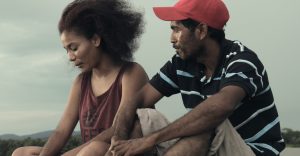Soundscapes of Memories: Safekeeping folklore through sensory immersion
As the sun sets in the Costa Chica region of Oaxaca, Mexico, a boy chases lambs around an open field. His joyful demeanor eclipses everything in his surroundings, while he seems unfazed by the adult voice calling for him. All that matters in that precise moment is the elation felt in the act of mounting one of the frightened creatures, the consuming allure of dusk tinging the scene with its nostalgic tonalities, and the hypnotizing soundscape of the countryside.
In itself, this sequence might read no differently than any one of hundreds of daily occurrences that characterize Mexican rural life, yet the pictorial quality inherent in this sequence is deeply ingrained in the specificity of its setting: the forgotten town of San Marquitos. Built from the ground up after the original settlement was washed away by Hurricane Dolores in 1974, San Marquitos is virtually unheard of beyond its neighbouring pueblos. It exists in a geographical limbo rarely depicted in any cartographical representation of Costa Chica and historically overlooked by various government authorities. It’s as if the township didn’t even exist for those that haven’t encountered it; a mythical location that, for most, only manifests itself through word-of-mouth and the tales built around it. But San Marquitos is a very real, richly idiosyncratic coastal site brimming with life, where its population engages in a constant dialogue between ancient traditions and contemporary concerns.

In Mexican filmmaker Antonio Hernández’s They Made Us the Night (Nos Hicieron Noche), both sides of this Oaxacan community stand in juxtaposition. On one hand, their everyday rituals are experienced and narrated by local protagonists, letting the sum of their collective memories assemble a fluent first approach towards historiography. Simultaneously, the borders between nonfiction and fiction begin to blur once the film establishes a point of convergence among the scripted moments of folk iconography and its adventurous formal pursuits. The result is an expressive portrait of one of the many faces of Afromestizo culture in Costa Chica.
They Made Us the Night’s hybrid narrative follows the circadian cycle of the Salinas Tello family while preparing for San Marquitos’ upcoming patronal festivities. Their reminiscences are initially shown in intimate close-ups but progressively expand into an almost omnipresent voiceover that guides the impressionistic recollections of the adjoining sights. In spite of its premise and its observational sequences, the film goes beyond the traditional ethnographical approximations so prevalent in contemporary documentary filmmaking, engaging directly with its protagonists in order to collaboratively construct its conceptual anchor.
Throughout Hernández’s imaginative manipulations with form, multiple registers are interwoven in a way that complements its leading premise of tradition bursting through the veil of perceived reality. In each of They Made Us the Night’s frames, there’s an almost palpable sense of wonder about the situation at hand, a near correspondence with the perspective of Adonis, the youngest member of the Salinas Tello clan, who’s also having his first encounters with the richness of his cultural background. The film exudes this spirit in its every gesture, from Adonis stumbling around farm animals to the freewheeling camera that follows his erratic trajectory and shares his sweeping excitement.
In a way, the film fixates on every visual and sonic texture just enough to feel transcendental. The boundless vistas of the pacific become progressively abstracted as the dancing cinematography is engulfed in local rituals. The enveloping sound design finds rhythmic nuances in the most mundane of sounds, and steadily distorts them into a hyperrealist carnival. Once immersed in such sensory overload, the distinction between reality and expression becomes irrelevant. The only thing to do is follow the devils into the forest and let the music guide the next step.
Alonso Aguilar
Edited by José Teodoro
© FIPRESCI 2021
